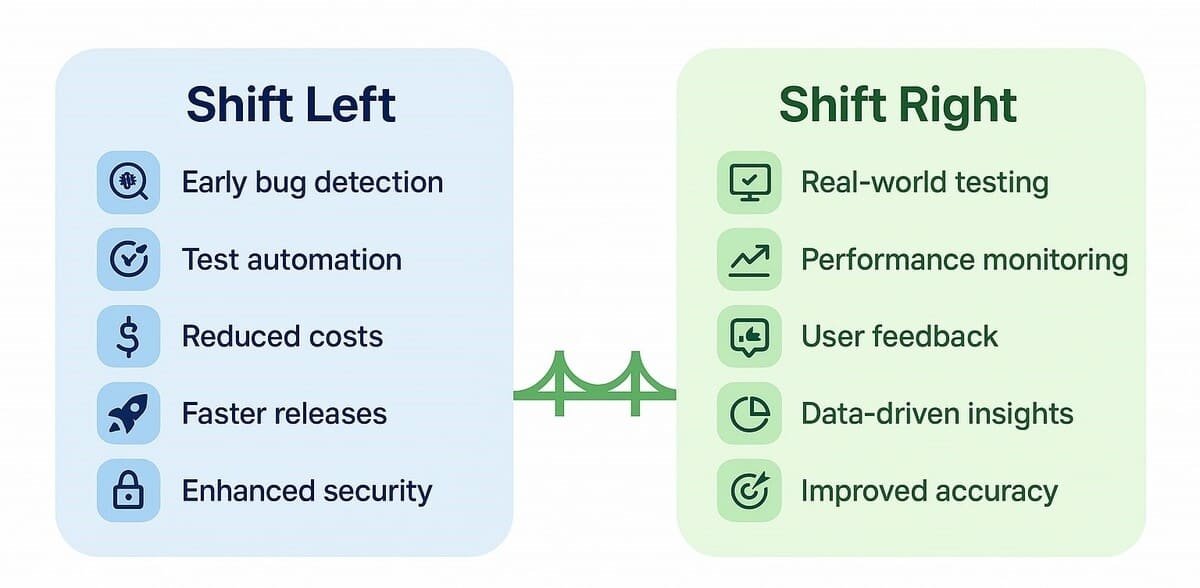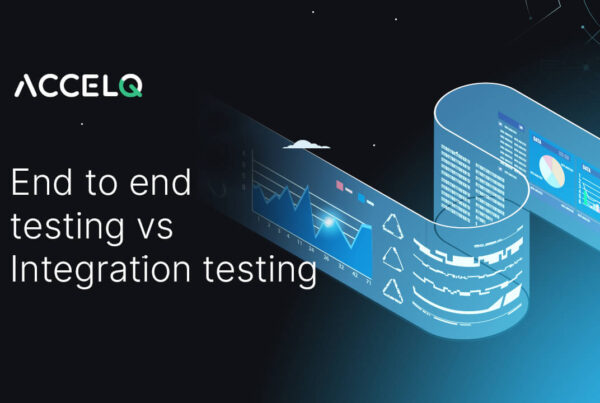Shift Left vs Shift Right: Bridging Quality Across the SDLC

Shift Left vs Shift Right testing are two distinct methods that determine when testing actions are executed within the SDLC. Shift Left Testing boosts early testing, preferably during the development or even necessities stage, to catch errors sooner & minimize expensive fixes later. Shift Right Testing, on the flip side, tests software in actual conditions after deployment, emphasizing performance, consistency, accuracy, and customer behavior. By understanding the rewards and timing of each method, expert teams can better align test efforts with business goals.
What is Shift Left and Shift Right?
Understanding Shift Left Testing
This type of testing focuses on advancing test actions earlier in the SDLC as a development methodology. By integrating testing into the entire process, the expert team can enhance software quality and cut costs rather than wait for flaws to be found and fixed at the end of development.
Advantages of Shift Left Testing
- Better Software Quality: Early error identification results in top-quality software.
- Rapid Time to Market: By detecting & fixing flaws early, development time is decreased.
- Reduced Costs: Bug fixes made early in the SDLC are less expensive than those made later.
- Enhanced Security: Security testing can be integrated early, guaranteeing the app is safe.
Understanding Shift Right Testing
This form of testing is a development approach where testing & QA are performed after deployment, usually in a production environment. Its primary goal is to evaluate the app’s usability, functionality, and dependability in real-world scenarios. Shift left testing, which concentrates on early testing throughout the SDLC, is in contrast to this strategy.
Advantages of Shift-Right Testing
- Enhanced Software Accuracy: By testing in production, shift-right testing helps detect & fix errors that may not be apparent in other environments, resulting in reliable software.
- Improved User Experience: This kind of testing guarantees that the app runs as projected under actual situations, enhancing the user experience.
- Data-driven Insights: By assessing user behavior and production traffic, shift-right testing offers valuable information to optimize performance, detect bottlenecks, & enhance upcoming development efforts.
- Rapid Time to Market: This form of testing can expedite rapid releases by enabling QA experts to detect & fix problems in production, decreasing the necessity for extensive post-release testing.
Key Differences Between Shift Left Testing vs Shift Right
Shift Left and Shift Right testing collaborative techniques that emphasize distinct phases in software development. Shift Right emphasizes post-deployment assessment and user feedback to detect flaws in production, whereas Shift Left testing, when done right, focuses on early bug identification and prevention by incorporating testing into early phases.

Key Differences Summarized
| Feature | Shift Left | Shift Right |
|---|---|---|
| Emphasis | Error prevention & detection in the early phase. | Real-time performance, accuracy, & customer feedback. |
| Timing | Initially, in the development lifecycle. | Post-deployment in production. |
| Testing Techniques | Automation, Test-Driven Development (TDD), Integration, and Unit. | Production testing, assessment, & customer reaction. |
| Advantages | Early error detection, decreased costs, and better quality. | Improved accuracy, user satisfaction, and actual error detection. |
When should you use Shift Left vs Shift Right?
When to use Shift Left:
- Early error finding & prevention.
- Test Automation.
- Replicated environment testing.
- Better teamwork.
- Decreased software development cycles & expenses.
When to use Shift Right:
- Real-time authentication.
- User feedback & scrutiny.
- Performance optimization.
- Flexibility to growing needs.
- Assessment & logging.
Tools Supporting Shift Left and Shift Right
An extensive suite of tools supports Shift Left and Shift Right testing approaches, supporting experts to automate quality checks early in software development & monitor and authenticate performance post-launch. Let’s examine how tools complement each strategy:
Shift Left Testing Tools:
- Jenkins – This tool can be integrated easily with test suites to conduct test automation on every build.
- SonarQube – For static code scrutiny & early identification of code smells or bugs.
- TestNG, JUnit– Unit test frameworks to authenticate code early.
- ACCELQ – A codeless automated testing platform that expedites Shift Left initiatives by enabling both tech & non-tech users to design and run testing early in the SDLC.
Shift Right Testing Tools:
- Dynatrace, New Relic– Monitor apps in production & give performance insights.
- ELK Stack, Splunk– Log aggregation & scrutiny tools that support QA engineers in understanding post-deployment problems.
- ACCELQ – It also supports Shift Right testing with its real-time validations, smooth integration into CI/CD pipelines, & support for behavior-driven testing in production environments.
ACCELQ Bridges Shift Left & Shift Right
This pristine no-code, automated AI-based tool bridges the gap between shift left vs shift right testing by providing a unified platform supporting QA across the complete development lifecycle. In agile environments where CD (continuous delivery) and fast response are crucial, ACCELQ empowers experts to execute both strategies efficiently.
For shift left testing, the platform allows early test automation at the demands and development phases, guaranteeing flaws are detected before they progress downstream. Its in-built design enables both business analysts and QA engineers to collaborate on generating test cases even before a single line of code is created, thus aligning flawlessly with agile principles.
For shift right testing, it integrates smoothly with CI/CD pipelines, enabling real-time authentications in staging as well as production environments. ACCELQ supports behavior-driven validation, post-deployment assessment, and regression scrutiny based on real-world user interactions, making it suitable for guaranteeing quality after launch.
By enabling shift left vs shift right testing in agile, ACCELQ supports QA experts to streamline feedback loops, minimize risk, and deliver superior-quality software rapidly without demanding to switch contexts or tools.
Real-world scenarios or Use Cases
To better comprehend the real-world application of these approaches, consider some shift left testing vs shift right examples in real-time software projects. In Shift Left testing, the expert team integrates automated API and unit testing during the sprint planning stage to find logic bugs before code is mixed, reducing rework and saving time. On the flip side, a Shift Right situation may include deploying a fresh feature with feature flags and making use of real-time evaluation tools such as ACCELQ to confirm performance under live traffic. These instances demonstrate how early prevention and post-launch validation can function simultaneously to fortify the software quality lifecycle.
Conclusion
Combining both Shift Left Testing vs Shift Right guarantees E2E quality across your agile pipeline. With incredible tools like ACCELQ, you get a unified platform that empowers early automated testing and real-time production authentication, without crafting code.
Begin your quality-first journey with ACCELQ now and expedite both sides of testing!
Prashanth Punnam
Sr. Technical Content Writer
With over 8 years of experience transforming complex technical concepts into engaging and accessible content. Skilled in creating high-impact articles, user manuals, whitepapers, and case studies, he builds brand authority and captivates diverse audiences while ensuring technical accuracy and clarity.
You Might Also Like:
 What is Non Functional Testing? Types & Example
What is Non Functional Testing? Types & Example
What is Non Functional Testing? Types & Example
 E2E vs Integration Testing: What QA Teams Need to Know?
E2E vs Integration Testing: What QA Teams Need to Know?
E2E vs Integration Testing: What QA Teams Need to Know?
 Test Case vs Test Scenario: Know the Key Differences
Test Case vs Test Scenario: Know the Key Differences
































